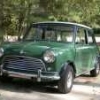Mk1 Identity
#1

Posted 30 March 2008 - 03:27 PM
I have just got hold of a Mk1 Mini that needs a total rebuild, the thing is it has lost all the paperwork and plates over the years (due to it being totally stripped) so I don't have a reg number/v5 for it, in fact I do not even know what year it is! (is there an easy way to tell?, the current owner mentioned high mounting points on the b pillar for the seatbelts?)
So is there anyway I can get the reg (V5 etc) back for the car?, it still has it's original chassis plate, engine number and another plate on the N/S inner wing spot welded to it
Many thanks
LeeBee
#2

Posted 30 March 2008 - 03:31 PM
#3

Posted 30 March 2008 - 03:40 PM
Really doesn't sound like a Mk1 to me. What is on this plate on the inner wing?
It is deffo a Mk1, the plate is stamped (cannot remember if just numbers or letters too) near the radiator shroud/cowling, (this sticks out from the inner wing)
I suppose it could be a mk2, but if this is the case someone has welded on a very original looking rear panel, it also appears to have the smaller rear window
All I know is that it is an Austin 850, it has a pill shaped chassis plate and needs a lot of work!
#4

Posted 30 March 2008 - 03:50 PM
#5

Posted 30 March 2008 - 04:48 PM
Well if it is and it has lost its registration you will have to re-register it. It will be possible to get an age related registration if you can prove its age. It will probably have to go through a VIC check. Do you have any photos?
I don't have any photos at the moment as it is still with it's current owner, hopefully I will be getting it in the next week or so
#6

Posted 30 March 2008 - 05:04 PM
pics would also help.
the plate above the rad shroud is possibly the "FE" number, these were never recorded and have little to no significance.
#7

Posted 30 March 2008 - 05:17 PM
if/when you get it, PM me anything on the chassis plate and any/all the other numbers you can find and I'll see what i can work out.
pics would also help.
the plate above the rad shroud is possibly the "FE" number, these were never recorded and have little to no significance.
Thanks, I will make a call and see if I can get some pics before I get it
#8

Posted 30 March 2008 - 05:42 PM
Look at the headlight dimmer switch on the floor. A production month and day for the switch are on it somewhere.
Look at the cover for the square wiper motor, as above, you'll find a production month/day for the motor.
Look at the boot lock mechanism... as above.
Buy or borrow a copy of Parnell's book on the Mini Cooper and -S. Read the section on reading the Triplex glass dot codes. (No... it doesn't have to be a Cooper or -S for this to apply).
Look at the sliding windows. If you have metal latches (as opposed to black and white plastic), that would indicate a production date before mid-1963.
Look at the back of the speedometer. If NO voltage stabilizer is found at the top of the speedo the car is pre- Septemeber 1964.
If the speedometer is VERY early it may have a metallic face with a red pointer instead of the more traditional black face.
Look at the outside door handles. If there are little chrome bosses on the door skin that more or less line up with the tips of the levers when the door is closed, the car was built after mid-1966.
I'm sure there are other clues but these are the ones that come quickly to mind.
by the way, that stamped plate on the radiator cowl isn't much good, nor is any number you find on the floor in the r/h footwell. Mk1s will have a body number plate welded to the slam panel next to the bonnet latch area. The VIN number is on a traditional reverse stamped aluminum plate screwed to the radiator cowl. The engine number will be on a reverse stamped plate riveted to the top of the engine block just behind the dynamo.
#9

Posted 30 March 2008 - 06:00 PM
Even w/o paperwork you can look for clues on the car that may help narrow its year down... as long as it's not a "bitsa".
Look at the headlight dimmer switch on the floor. A production month and day for the switch are on it somewhere.
Look at the cover for the square wiper motor, as above, you'll find a production month/day for the motor.
Look at the boot lock mechanism... as above.
Buy or borrow a copy of Parnell's book on the Mini Cooper and -S. Read the section on reading the Triplex glass dot codes. (No... it doesn't have to be a Cooper or -S for this to apply).
Look at the sliding windows. If you have metal latches (as opposed to black and white plastic), that would indicate a production date before mid-1963.
Look at the back of the speedometer. If NO voltage stabilizer is found at the top of the speedo the car is pre- Septemeber 1964.
If the speedometer is VERY early it may have a metallic face with a red pointer instead of the more traditional black face.
Look at the outside door handles. If there are little chrome bosses on the door skin that more or less line up with the tips of the levers when the door is closed, the car was built after mid-1966.
I'm sure there are other clues but these are the ones that come quickly to mind.
by the way, that stamped plate on the radiator cowl isn't much good, nor is any number you find on the floor in the r/h footwell. Mk1s will have a body number plate welded to the slam panel next to the bonnet latch area. The VIN number is on a traditional reverse stamped aluminum plate screwed to the radiator cowl. The engine number will be on a reverse stamped plate riveted to the top of the engine block just behind the dynamo.
Funnily enough I have just been thumbing through Parnell's book on the Cooper!, the metal plate I was thinking of was the FE number but there is both the engine number and chassis plate present.The car is full of spares so I cannot get to specific parts to look at the moment, one thing that was of interest was the postion of the seatbelt anchorage on the B pillar, it states in Parnell's book that pre June 1963 models had this much higher than late models, mine has this right up near the top of the pillar T section (page 28 of Parnells' Cooper book) so might shed some light as to it's age
Hopefully should have some info a bit later today
#10

Posted 30 March 2008 - 06:04 PM
what they were i could not tell you but i recieved my log book after 4 weeks. The paperwork swung it for me I guess.
#11

Posted 30 March 2008 - 07:38 PM
The body number on the slam panel is the only body related ID number that Heritage may be able to use to define the age of the shell. All the other bits are removable and may be from other shells.
#12

Posted 30 March 2008 - 08:22 PM
#13

Posted 02 November 2016 - 05:01 AM
I introduce myself. my name is raul and speak from Madrid, Spain. I am an enthusiast mini, actually I have two (one austin mini cooper 1000 mk2 and mk3 AUTHI) and I've always wanted a mk1. I now presents the opportunity of buying a mk1 for renovation in portugal. the owner sent me photos, documents and plate vin (although this very old and is a little weird ... numbers printed above, not from back to front). VIN number plate matches the document owner. my question is: should have a VIN number stamped on the car body somewhere? You should have some body number stamped on the body? the number of the body necessary to rehabilitate the car or just with the VIN plate is enough? the car is a super seven deluxe austin 1962 (A-A2S7SL-XXXXXX). in the closing cross Bonnet has no number stamped body. only one plate welded to the sleeper laying in large letters "NMP". not what it is but if you've seen pictures on the internet like another car, also Portuguese, who had beaten. The car also has another key next to the VIN plate on the radiator that says "FE32XXXX". The body is just right for this car? as I know which is the number of the body? Please I need your help. I need to confirm that the car is correct before buying. I thank you in advance for your help.
thank you very much!!!
#14

Posted 02 November 2016 - 11:00 AM
¿Tienes cualquier fotografias del coche?
Gracias y Buen suerte, Pete.
#15

Posted 02 November 2016 - 01:40 PM
I always remembered that pre '63 Minis didn't have a seatbelt mounting on the B pillar. I remember selling seat belt kits for earl Minis which meant you had to drill the top of the B pillar and insert a spacer tube to strengthen the fixing point.
1 user(s) are reading this topic
0 members, 1 guests, 0 anonymous users


















